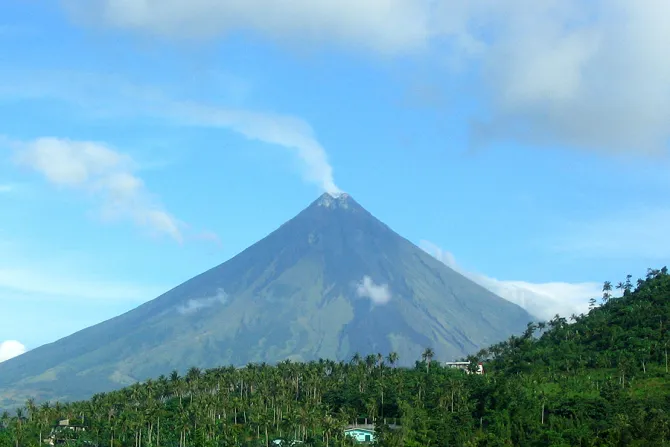Legazpi City, Philippines, Sep 20, 2014 / 15:04 pm
Residents near the restive Mayon volcano in the Philippines are turning to prayer as the mountain begins to erupt, and the nation's Catholic charity agency is preparing to help those whose lives are disrupted.
A lava dome appeared at the top of Mayon volcano last month, and on Sept. 15 increased rockfall and seismic activity led the Philippine Institute of Volcanology to raise the alert level to three (on a scale of zero to five), which indicates high unrest, magma at the volcano's crater, and a possible hazardous eruption within weeks.
The government has forcibly evacuated more than 27,000 residents from an six kilometer (four mile) radius around the volcano.
On Friday, there were reports of lava flowing down the mountain's slopes; 22 seismic events; 70 rockfalls; and lahar, a volcanic mudflow with a consistency similar to that of wet concrete. According to International Business Times, seismologists describe Mayon as "erupting already but not at an explosive level."
Fr. Nic Bilono, rector of St. Gregory the Great cathedral in Legazpi City – which is a 28 mile drive from the base of Mayon volcano – told CNA Sept. 17 that the evacuees "have moved to safety in nearby schools," adding that "the livestock are kept safe near some protected slopes."
While St. Gregory the Great is a 28 mile drive from the volcano, the round-about drive is much longer than the nine mile distance separating the two.
Despite this, the cathedral is safe, Fr. Bilono reports, "due to the hilly topography surrounding the area … the molten lava has erupted but not actually exploded, and is gushing down the slopes."
The local people are typically "deeply religious," the priest said, adding that when calamity strikes "the conviction of faith unites the people to pray fervently, imploring the saints and especially Our Lady of Salvation, the patroness and protectress of the Diocese of Legazpi."
"Prayer work miracles, and only God can save us."
Fr. Bilono also noted that the diocese has established "oratio imperata", or "ordered prayer", which is recited in times of calamity, and traditionally said at the end of Mass.
The oratio imperata are being recited daily throughout the Legazpi diocese, and parishes are monitoring the situation for the safety of their people, Fr. Bilono said.
Meanwhile, the humanitarian relief agency of the Filipino bishops, Caritas Manila, is preparing to assist those whose lives will be disrupted by Mayon's eruption.
Caritas Manila "is closely watching the situation, and is waiting to receive further updates from the local dioceses," Gilda Avedillo, the agency's disaster risk reduction officer, told CNA Sept. 15.
Closely aligned to Caritas Manila is the Quiapo Church Disaster Preparedness and Response Ministry (DRRM), a scientific office of the local Church which monitors prospective natural disasters in the island nation.
DRRM also provides up-to-date text messages to registered users, so that they can make preparations and take safety measures when a disaster is expected, helping to prevent casualty and loss of life.
A member of DRRM informed CNA that information on typhoons and earthquakes, as well as the recent eruptions at Mayon, are instantly revised and published on the ministry's website to help people track the latest information.
DRRM was launched in 2012, and collaborates with the Philippine Institute of Volcanology and Seismology and other government agencies to share data, maps, software, and databases.
The information provided by DRRM could help to save the lives of those threatened by Mayon volcano.
Mayon is located towards the southern end of Luzon, the Philippines' largest island, in Albay province.
Luzon often experiences typhoons, and is currently recovering from Typhoon Glenda, which struck in July and killed more than 1,000.
The current safety alert for Mayon volcano covers Legazpi City, Tabaco City, and Ligao City, and the towns of Guinobatan, Camalig, Daraga, Santo Domingo, and Malilipot.
Albay's economy is largely agricultural, and were Mayon to have a hazardous eruption, farmlands, coconut plantations, poultry, and livestock would all be gravely harmed.
The volcano is the country's most active, having erupted more than 50 times over the past 200 years, and is renowned for its nearly perfect symmetry
Its most destructive eruption was that of 1814, which buried entire towns in ash and killed more than 1,200.


